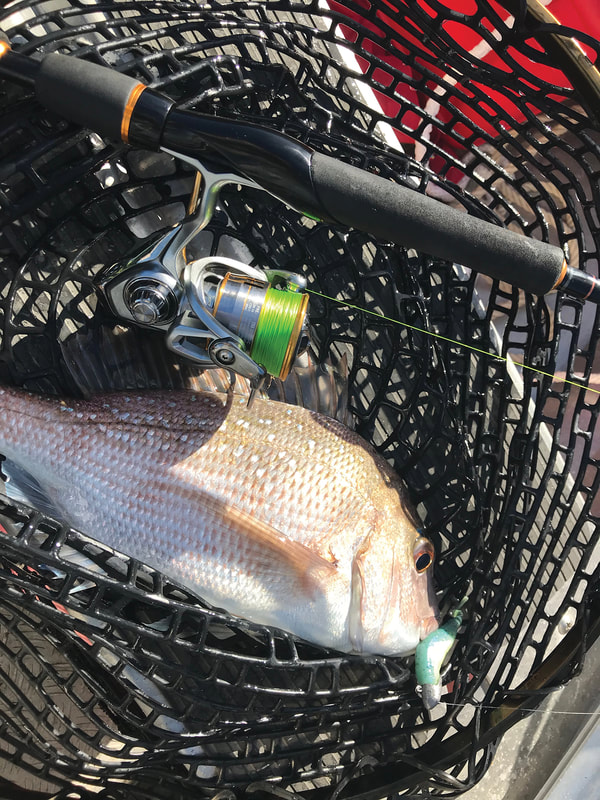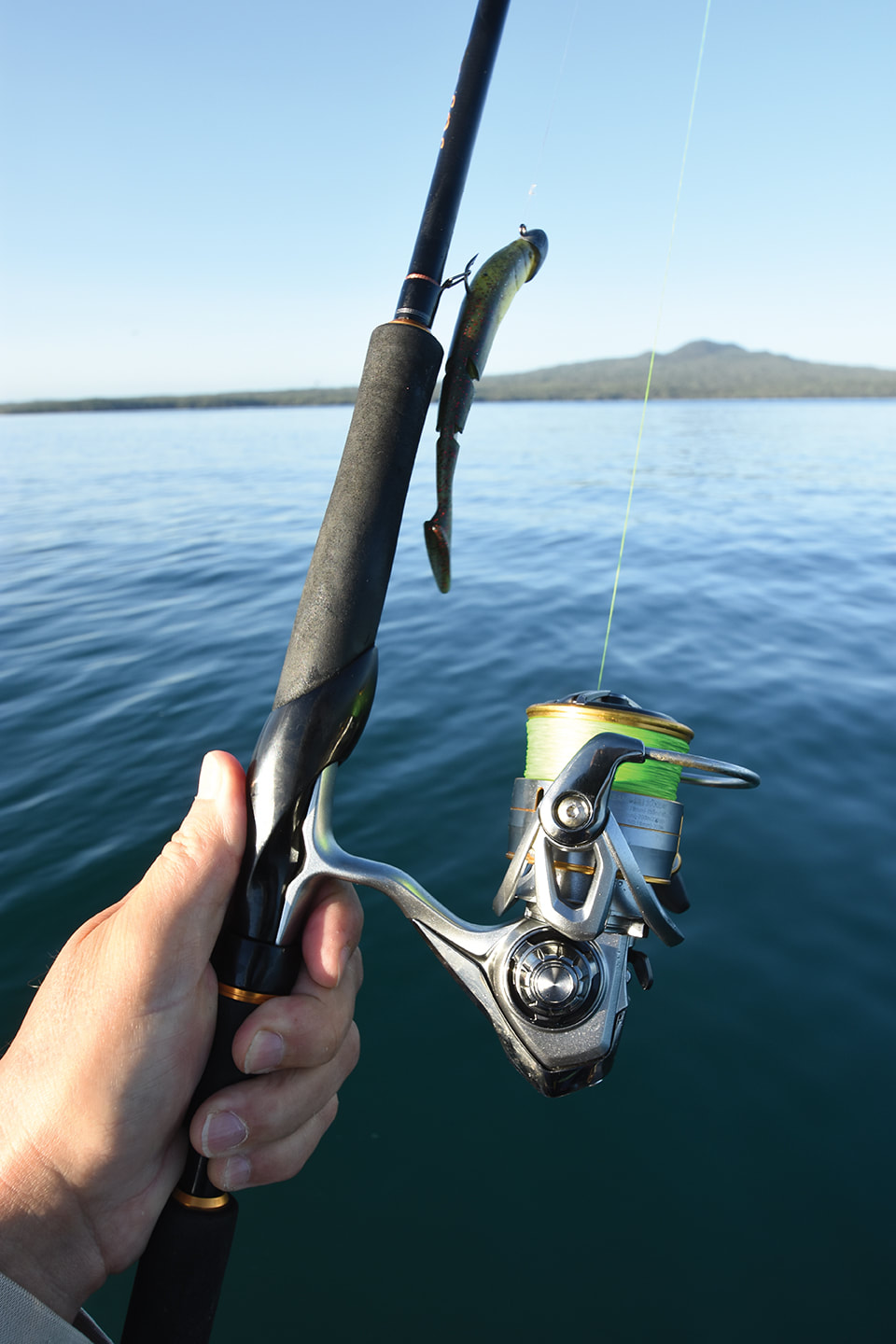|
Specifications
FREAMS LT 3000D-C
For more info go to: https://www.daiwa.co.nz/
|
When Daiwa NZ couriered this baby to my door, along with a very tasty 2.3 metre (7 foot six-inch) two-piece Sol TD rod in black with black bindings and gold highlights, I began salivating.
The Freams features a high-strength aluminium body that incorporates Daiwa’s proprietary ‘Magseal’ technology. Magseal is a magnetised lubrication system which all but eliminates water penetration via the main shaft and ensures perfect lubrication for exactly the parts that need it. Magseal reduces friction and dust intrusion, eliminates oil spray and improves durability. The Magseal technology was introduced a few years ago to Daiwa’s top-end spinning reels, such as Saltigas, but has since trickled down through Daiwa’s model range. Freams reels sit in the upper-middle of Daiwa’s hierarchy in terms of price, but the LT 3000D-C has a high quality look and feel and lots of tech that was previously only available on more expensive models. I was really looking forward to taking it fishing. But first I had to spool it. Daiwa NZ supplied 300 metres of chartreuse, 15 pound, 1.9 mm diameter J-Braid, a multi-carrier PE braid that I have used on other reels and really like. I had to have two goes at spooling the reel though, the second time adding a spacer washer (supplied) under the spool to get a nice even line lay. The machined aluminium ‘ABS’ spool is shallow-ish with a nominal capacity of 300 metres of PE 1.5 braid, but I didn’t quite squeeze that much J-Braid on ̶ closer to 250 metres, plus a bit of nylon backing to prevent the line load slipping on the spool. Unlike Penn and ABU, Daiwa doesn’t go in for ‘braid ready’ anti-slip spools with rubber coated arbors. Spooled up and with a couple of metres of 16 pound Daiwa fluorocarbon trace knotted to the end of the braid, I screwed the reel onto the TD Sol rod and went fishing. First impression: it’s light! Daiwa has gone to considerable trouble to minimise weight with this reel ̶ LT stands for ‘light’ and ‘tough.’ Weight-saving features include the ABS spool, a slim ‘Aluminium Air’ handle, ‘Air Bail’ (a hollow bail arm) and a lightweight composite ‘Air Rotor’. All up, the reel weighs just 215 grams, plus the line. The rod’s lightweight too, thanks to its high-modulus graphite construction and ‘HVF’ nano technology. Rated for 4-9 kg lines and lures of between 7 and 28 grams, it’s just the sort of soft bait rod I like, and an interesting contrast to my 12-year old TD Sol. It’s an older-generation seven-foot Daiwa rod that was my go-to for years and is still used regularly, but which feels heavy and unresponsive compared to this one. In recent years I’ve moved to longer rods for most of my soft plastics fishing, so the extra six inches (compared to my old Sol) is welcome. Some rods are longer still, but 2.3 metres offers the benefits of extra reach without being too unwieldy. I like that it’s two-piece as well ̶ long one-piece rods are difficult to transport inside a car. My second impression, upon hooking a horse kahawai from an anchovy work-up, is that the ATD drag (Automatic Tournament Drag) is absolutely superb. There is no start-up inertia whatsoever and it gives line smoothly to protect light lines on the strike. Daiwa has achieved this by better supporting the spool to avoid spool twist under heavy loads. The drag washers are protected from water intrusion by a rubber seal under the drag knob. The ATD drag works really well ̶ almost too well for some situations. To avoid slip, I sometimes found myself using more drag than is prudent to ensure a positive hook set at a distance or in deeper water. This often had me scrabbling to ease the drag when the fish took off on a run. I’ve since taken to striking with a forefinger on the spool rather than tightening the drag too much. The super-smooth drag also allows ‘line creep’ when you are fighting or trying to lift a strong fish, but of course the drag is protecting the line when it does this. It’s simply that most other reel drags are not that smooth. Again, judicious use of a finger on the spool can stop line creep, but be careful ̶ the reel drag is more sensitive than your finger. Because it’s so smooth, it’s easy to underestimate how much drag pressure is being applied. The reel is capable of exerting 10 kg of drag, which means you can easily snap light fluorocarbon traces and even PE braid if you are too heavy-handed. On the other hand, when you really need to put the hurt on, the drag won’t let you down by binding, jerking or chattering ̶ it remains silky-smooth right up to maximum pressure. In fact, smoothness is a feature of the reel’s operation. Five shielded (CRBB) corrosion-resistant ball-bearings, plus the bail roller bearing, take care of the rotating parts, and the Freams range has Daiwa’s upgraded ‘Tough Digigear’ technology inside the compact reel body, keeping everything in perfect alignment under pressure. Tough Digigear sports larger-diameter main gears with bigger teeth for superior meshing, and is said to be 50% stronger than Digigear II. The gear ratio is 5.3:1, which retrieves 80 cm of line per crank of the handle. That is plenty fast enough for soft bait fishing and also for light jigging duties. I’d be happy to own this reel, and the rod as well. In fact, I may have to do a deal with Daiwa…. I’m impressed with the Fream’s quality feel and love the way it performs, though it took me a couple of fish to come to grips with its ultra-smooth drag (which I love). With a price tag of $289.99, it’s comparable with popular mid- to high-end light spinning reels from competing brands, none of which offer Magseal technology, as well as other reels in the Daiwa range. Price-wise, it slots somewhere in the Daiwa range between the more expensive TD Sol II and Saltist Magseal, and the cheaper Saltist Nero Magseal and BG series reels, but shares much of the technology of Daiwa’s premium Certate and Branzino light spinning reels. That can’t be bad. I only hope Daiwa has sorted out the bail arm roller bearing for the new Freams, a weakness on every Daiwa light spinning reel I’ve ever owned… |

